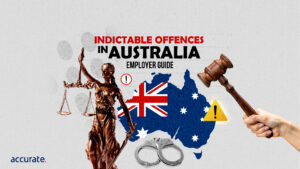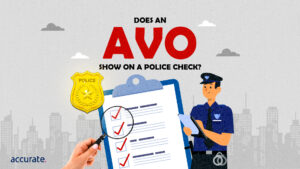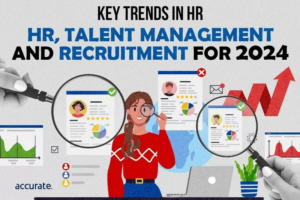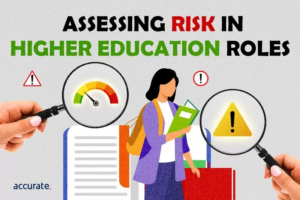ACIC Guidelines
VerifyNow Pty Ltd trading as Accurate Background in Australia is an accredited body with the Australian Criminal Intelligence Commission (ACIC). You can verify this by visiting the ACIC’s Accredited Bodies Page and expanding the section titled ‘Accredited bodies authorized to offer a service directly to members of the public and other organizations (Legal Entity Customers)’, where you will see VerifyNow Pty Ltd listed.
According to the ACIC, being an accredited body means that you are “entrusted with direct access to the National Police Checking Service (NPCS or Service) and play a vital role to help safeguard the Australian community”. This accreditation allows us to carry out National Coordinated Criminal History checks, directly through ACIC, providing a timelier solution for our customers.
This accreditation also brings with it responsibilities. One of these responsibilities is the requirement that all accredited bodies verify the identity of the individual being checked and establish a link between the individual and their claimed identity.
What is the DVS and How Does it Work?
Accurate Australia uses a gateway service provider to verify identity documents via the Document Verification Service (DVS). The DVS is a function of the Australian Federal Government’s Identity Matching Services which compare personal information on identity document against existing government records, such as passports, driver licences and birth certificates.
While the DVS is an important component of the identity verification process, it isn’t the only step that needs to be taken. The results from a DVS check simply show whether or not the biographical information on the provided identity documents matches the original record and will show either a “yes” or “no” result.
To be assured of someone’s identity we also need to link the person providing the documents to the claimed identity. Accurate Australia does this through the use of a selfie photograph where the candidate holds up their physical identification, hence providing a link between the document and the person.
How Does an Identity Verification Check Work?
Due to the requirements of the ACIC as discussed above, all candidates undergoing a police check also get their identity verified as part of this process. As police checks are one of the most common forms of employment screening, most candidates being screened as part of a recruitment process will have their identity verified in this way, as a component of the police checking process.
For an identity verification carried out as part of a police checking process, these are the steps involved:
- Depending on the version of the police check being carried out, the candidate provides the relevant identity documents:
- For an ACIC Nationally Coordinated Criminal History check, 4 types of documents are required: 1x commencement document, 1x primary document, and 2x secondary documents.
- In some cases (such as a check carried out by an international employer), ACIC cannot be used. In these cases, a police check can be carried out by the Australian Federal Police. For an AFP check, the 100 points identification system is used.
- Before any identity document details are passed onto ACIC or the AFP, a DVS check is carried out to verify their validity.
- A selfie photo of the candidate holding their identity documents is provided to Accurate Australia to link the candidate to their documents.
- Once the validity of the documents and a link between the candidate and the credentials has been confirmed, they are passed on to either the AFP or ACIC who carry out the criminal history check and return the results to Accurate Australia to then pass on to the customer.
If there is no police check being carried out but other checks such as qualification checks are required, Accurate Australia can carry out their own identity verification using a commencement document (e.g. Passport or Visa) and a primary document (e.g. drivers licence). These documents are both verified using the DVS, and linked to the candidate using the selfie photo.
Identity Proofing Guidelines and Levels of Assurance
The Federal Government’s Department of Home Affairs has released National Identity Proofing Guidelines, which form an important role within the overall National Identity Security Strategy.
These guidelines recognise that not every identity check represents the same level of potential risk, stating:
“It will not always be necessary or appropriate to confirm a person’s identity with a high degree of confidence, particularly for transactions or services that are low value or involve low levels of risk. These Guidelines therefore adopt a risk-based approach to identity proofing using varying Levels of Assurance (LoA) that can be applied commensurate with the level of risk involved in any particular context.”
The table below lists the four levels of assurance that can be used to rate the confidence that should be placed in an identity-proofing transaction. The highest level of assurance for proofing that can be carried out remotely is the Silver Standard or “High” level. This is the level under which Accurate Australia operates.
| Level of Assurance | Description | Aim | Controls | Method |
|---|---|---|---|---|
| 1 – Low | Little confidence in the accuracy or legitimacy of a claimed identity. Appropriate for transactions with minimal consequences to the organisation or community from registration of a fraudulent identity. Examples may include commercial email providers which require assurance that an imposter has not gained unauthorised access to an account, although the account itself could be created using a pseudonym. | Identity is unique within the context. | Self-claimed or self-asserted identity (pseudonymity is possible, but not anonymity). | Local or remote |
| 2 – Medium (‘Bronze standard’) | Some confidence in the claimed identity. Appropriate for transactions with some consequences associated with registration of fraudulent identities, such as access to a service by an ineligible person and/or some minor consequences to the community from registration of a fraudulent identity. Examples may include provision of some low value/risk services, such as registration for a library card or rental of goods. | Identity is unique within the context, identity is recognised by authoritative sources and identity is used in other contexts. | Evidence of identity through use of identity information or documents from authoritative sources. | Local or remote |
| 3 – High (‘Silver standard’) | High confidence in the claimed identity. Appropriate for transactions with serious consequences associated with fraudulent registration, such as allowing access to sensitive information, systems or people, including those of organisations other than that which undertook the initial identity proofing. Examples include issuance of documents and credentials used as secondary evidence of identity in the community (see Appendix B). | Identity is unique within the context, the identity is recognised by authoritative sources, identity information is verified with authoritative sources, identity is used in other contexts and the person is linked to the identity. | Evidence of identity through use of identity information or documents from authoritative sources + information or documents verified with an authoritative source. | Local or remote |
| 4 – Very high (‘Gold standard’) | Very high confidence in the claimed identity. Appropriate for transactions with very serious consequences associated with fraudulent registration to the organisation and/or significant consequences to the community from registering a fraudulent identity, such as from issuance of a document commonly used as evidence of identity. Examples include issuance of government documents used as primary evidence of identity in the community e.g. the Australian Passport. (The majority of requirements at this level align with the former GSEF) | Identity is unique within the context, identity is recognised by authoritative sources, identity information is verified, identity is used in other contexts and the person is linked to the identity. | Evidence of identity through use of identity information or documents from authoritative sources + information or documents verified with an authoritative source + individual witnessed in-person. | Local only |
Digital Credentials
One of the key objectives for the implementation of the National Identity Proofing Guidelines was to meet the community’s need for flexibility around identity-proofing transactions. Particularly the need for many people to be able to carry these out online.
In addition to an increase in remote proofing, there is also a growing appetite amongst both providers and consumers for a wider implementation of digital identity credentials in Australia. The NSW Government has announced the creation of an opt-in digital birth certificate, originally planned for 2022 but now slated for a 2023 release.
The opt-in digital credential is “being built on behalf of other registries across Australia as a test case for a nationally recognised system of verifiable credentials between states and territories”.
At the time of writing this page, there are already some digital credentials which can be used for identity proofing. At Accurate Australia we are able to use the NSW digital driver’s licence for both AFP, ACIC and standalone identity verifications.
The further digitization of identity credentials is an important step for organisations and individuals across the country and a topic that Accurate Australia will be following with keen interest.
Related Resources

Not sure which background checks to choose?
Businesses face challenges recruiting and retaining employees in today’s fast-paced world. Employees can be the greatest asset or the biggest risk of a business. Employment screening can help increase workforce integrity and trustworthiness. Let’s have a conversation so we can better understand your employment screening requirements.

Keep Up To Date!
Stay connected and up to date by subscribing to our newsletter. Get access to industry insights, our latest blogs, events and more.






